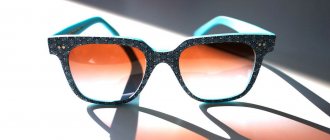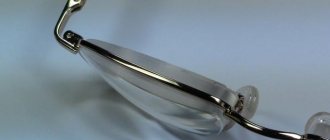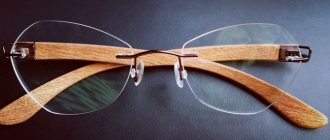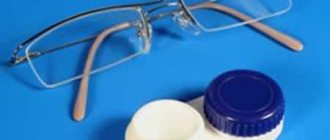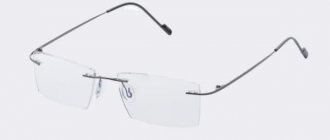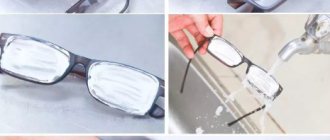Any person who needs glasses for the first time is faced with the choice of which model to choose: with plastic or glass lenses. One way or another, lenses made of plastic or glass have their positive and negative sides and it cannot be said that one of these materials is much better than the other. That is why factors such as the conditions and lighting in which you plan to wear glasses play an important role in choosing lenses.
Since glasses today are not only the most important attribute for visually impaired people, but also a stylish accessory, their choice must be taken seriously. This type of optics is used to protect against the negative effects of ultraviolet rays, for working at a computer, and reading books. But before purchasing any type, you should first of all pay attention not to their appearance and stylish frame, but to quality. In this case, it is the lenses that play an important role, so it is worth taking a closer look at the advantages and disadvantages of plastic glasses for vision.
Advantages of plastic
Of course, plastic glasses are less popular and people mostly prefer to buy glass ones. But nevertheless, this type has clear advantages, which include:
- Lightweight - this material is much lighter than glass. This advantage allows the use of semi-rimless frames in the design.
- Durability – plastic is definitely stronger than glass. When dropped, glasses will not crumble into tiny fragments. And if they break, then such fragments are much less dangerous.
- Unusual design - organic material allows you to paint lenses in a variety of shades, since it is much easier to process.
- More expensive models are coated with a special protective coating that prevents scratches.
Polycarbonate lenses for glasses
Back in the 50s of the last century, polycarbonate was discovered and since then it has been actively used in industry. Given its unique properties, polycarbonate has also found application in optics. At that time, its only drawback was the low level of light transmission. In the 80s, scientists began to work on this drawback and, with the help of innovative technologies, it is now possible to obtain an excellent material with a high degree of light transmittance .
Since then, the quality indicators of polycarbonate have improved significantly and they began to be used in the production of optics. Spectacle lenses are divided into two main types:
- mineral (glass);
- polymer (plastic).
The latter material has become increasingly popular among manufacturers of optical products. It is a thermoplastic synthetic material and was developed for space applications due to its high reliability. This property allowed it to be used for the manufacture of the front part of astronauts' spacesuits and for the production of spaceship windows.
The material combines many exceptional qualities:
- mechanical strength;
- elasticity;
- transparency;
- optical homogeneity;
- durability;
- low specific gravity.
The only drawback of polycarbonate glasses is that the material is solvent-resistant . For example, acetone can reduce the strength of the coating, so if you have such glasses, you need to be careful when handling solvents.
Disadvantages of plastic lenses
- Despite the fact that plastic glasses are coated with several protective layers that prevent the penetration of ultraviolet rays, this material still allows them to pass through. As a result, the pupils, deceived by dark lenses, relax and do not narrow, and the retina of the eyes receives the sun's rays. As a result, over time, clouding of the lens may occur. Vision may also noticeably deteriorate. One way or another, this drawback relates mainly to the sun protection type.
- Some budget models are prone to scratches.
- They also accumulate static electricity, causing dust to be attracted to them.
- An undoubted disadvantage is that such lenses become fragile when exposed to sub-zero temperatures.
Functions of glasses
The main functions include:
- Correction and restoration of vision.
- Eye protection from ultraviolet radiation.
In the old days, glasses lenses were made only of glass. But time does not stand still and plastic lenses have begun to appear on the optical markets. At first, this polymer could not compete with anyone (except perhaps in terms of weight and mineral raw materials), but today the development of this industry has stepped forward so much that it is sometimes even difficult to distinguish glass from plastic with the naked eye and without special markings.
The effect of plastic sunglasses on the eyes
To make lenses, two types of plastic are used, namely polycarbonate and acrylic. But if glass lenses really do not transmit ultraviolet rays, then plastic, regardless of the cost of a particular model, is still exposed to sunlight.
One way or another, plastic without additives causes some damage to the eyes. Over time, a person's vision inevitably begins to deteriorate, and in some cases, serious ophthalmological diseases may even occur. That is why, before purchasing, you should read the label, which should be located on the bow.
You should not buy glasses from a popular brand, since these indicators do not indicate their quality.
To avoid damage to the fundus of the eye, you should only buy glasses that protect your eyes from UVB rays, which cause the most serious damage to the eyes. Be sure to consult an ophthalmologist before purchasing.
Wearing sunglasses as you get older is a necessity. That is why, if the choice was made in favor of plastic, then you should study the label very carefully in order to avoid unpleasant consequences in the future. Low-quality sun lenses made of plastic will not only not protect your eyes from the sun's rays, but will also have a negative impact on them. In the future, if you constantly wear low-quality plastic glasses, cataracts and eye degeneration may develop.
Types of polycarbonate glasses
We looked at the advantages and disadvantages of polycarbonate glasses. It remains to understand the types of glasses made on the basis of this thermoplastic. Since polycarbonate can be easily processed mechanically and thermally, lenses of various colors, thicknesses and geometries are made from it. Moreover, you can buy not only safety glasses, but also ophthalmic glasses - in Russia there are organizations that produce polycarbonate corrective optics with the necessary diopters.
In stores you can find the following types of polycarbonate glasses:
- safety glasses of open and closed type. Open glasses are used to protect the eyes from dust, shavings and debris. Closed ones provide more reliable protection and are used when working on woodworking machines and metal-cutting equipment;
- welding glasses. Models are available with one pair or two pairs of lenses of varying transparency;
- sports glasses. Specialized models can be additionally equipped with a polarizing coating. Used for water sports, airsoft, skiing and snowboarding;
- polycarbonate sunglasses. It is worth noting the huge variety of glasses models of different shades, shapes and levels of light transmission. Finding a suitable option is guaranteed to be easy. Sunglasses made from polycarbonate material are available in metal, plastic or titanium frames; there are also models without frames;
- ophthalmic correction glasses. Through polycarbonate, the human eye not only sees the clearest and most undistorted image possible - lenses with diopters are also produced from this material for vision-correcting glasses intended for everyday wear.
To evaluate the strength of the material, it’s worth taking a look at the video of someone trying to damage a Harry Cooper ochki with a construction hammer.
Knowing what the advantages are, and also understanding what thermoplastic polycarbonate sunglasses are, you will most likely prefer them to traditional glasses made of mineral or plexiglass.
Which is better for the eyes: glass or plastic?
One way or another, having paid attention to the main qualities of plastic glasses, we can conclude that they are not the best for protection against ultraviolet rays.
That is why, for sun protection, it is better to choose glass glasses, which can guarantee almost 100% safety.
But the fragility of glass forces people involved in active sports to abandon them, since they are extremely unsafe.
In some cases, the glass breaks into very tiny pieces, which, if they get into the eyes, can seriously injure them and even lead to complete loss of vision. It is also better for children and drivers to prefer plastic, for the same reason.
Glass glasses are heavier and therefore many people complain that they put pressure on the bridge of the nose and interfere with blood circulation. It is in such cases that plastic comes to the rescue again.
Pros and cons of polycarbonate glasses
Glasses made from polycarbonate, produced in compliance with the technology, have enormous advantages and their performance characteristics significantly exceed models made of mineral glass. Their main advantages include:
- highest impact resistance. This can safely be called the most important quality of polycarbonate optics. Compared to glasses made of plexiglass or plastic, their strength characteristics are 10–12 times higher, and compared to mineral glass - more than 200 times higher. Which, in addition to practicality, makes the glasses highly safe - it is literally impossible to injure your eyes while wearing them;
- high durability. Like the vast majority of thermoplastics, polycarbonate is distinguished not only by impact resistance, but also by a long service life, during which its performance characteristics and appearance remain unchanged;
- light weight. It is for this reason that polycarbonate lenses are common in children's eyeglasses. Such optics do not put pressure on the bridge of the nose, are comfortable for everyday wear, and do not fall off the face. The approximate density of the material is about 1.2 grams per 1 cm3, which is significantly lower than the density of mineral and plexiglass;
- heat resistance. Safety glasses made of polycarbonate are widely used in industry - after all, the melting point of the material is as much as 140 degrees. At the same time, they dissipate heat, which eliminates the risk of eye burns. Certain types of safety glasses are allowed to be used at temperatures up to 130 degrees;
- UV protection. Unlike glass, the material does not transmit solar ultraviolet radiation. The polycarbonate used to make the lens does not require additional coating with photochromic or population film, which is often necessary for glass lenses;
- environmental friendliness. Thermoplastic belongs to the category of non-toxic materials and is completely safe for humans and the environment. It also belongs to the group of renewable thermoplastics because it is recycled;
- refractive index. For polycarbonate it is 1.6, for plain glass it is 1.7. Only high-quality mineral lenses, the cost of which is quite high, have an indicator similar to thermal paste;
- affordable price. Considering the production technology and the prevalence of polycarbonate material, making glasses from it is several times cheaper than making lenses from glass;
- safety. Even with a slight mechanical impact, polycarbonate lens optics do not break into traumatic fragments, but are simply deformed. It is this quality of the material that made it possible to produce polycarbonate glasses for sports, outdoor activities and protective optics for workers;
- practicality. Polycarbonate lenses fog up less with changes in temperature and humidity, and their surface is easy to clean;
- versatility. The polycarbonate lens material at the production stage can be painted in almost any color of the required shade and depth. Due to this, a huge selection of glasses of the most varied designs is provided.
The glasses are characterized by comfort during use. Polycarbonate lenses have made it possible to produce glasses with rimless frames, which not only look stylish and impressive, but are also extremely comfortable for everyday wear.
Disadvantages of optics
But this material also has a number of disadvantages. The main one is low hardness, which causes scratches to appear on the surface of the lenses. To avoid this, manufacturers apply special protective coatings to polycarbonate lenses to protect the surface from scratches during use. Additionally, this coating gives the glasses antistatic properties. However, glasses made from a material such as polycarbonate need careful storage and care - cleaning cloths are sold specifically for them, which do not leave scratches on the surface.
The second drawback is a direct consequence of the first - low light transmission compared to mineral glass. This is due both to the presence of an additional coating and to the light transmission properties of the material itself. But at the same time, the level of light transmission of polycarbonate lenses fully complies with all international standards and WHO requirements - a person sees a clear and contrasting picture through them. So this drawback can safely be classified as minor.
And if you choose between polycarbonate or glass for glasses, then the best solution would be to choose polycarbonate material. Glasses made from this material can last for many years without losing their quality.
Which lenses are better?
Why does this question even arise? As mentioned earlier, the quality of the first plastic left much to be desired. In order not to list all the shortcomings, we can focus on two, but those that were most noticeable and worried the owners, namely:
- slight mechanical damage, that is, a high tendency to form scratches on the lens of glasses;
- quickly reducing plastic to an unpresentable appearance.
Apparently, it is the old impression that makes us ask this question. To answer this, you need to compare glass and plastic lenses.

